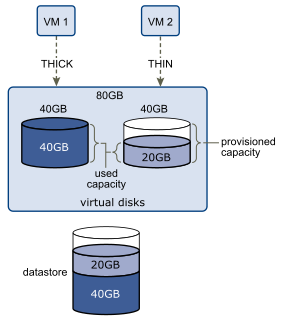When you create a virtual machine, a certain amount of storage space on a datastore is provisioned to virtual disk files.
By default, ESXi offers a traditional storage provisioning method for virtual machines. With this method, you first estimate how much storage the virtual machine might need for its entire life cycle. You then provision a fixed amount of storage space to the VM virtual disk in advance, for example, 40 GB. The entire provisioned space is committed to the virtual disk. A virtual disk that immediately occupies the entire provisioned space is a thick disk.
ESXi supports thin provisioning for virtual disks. With the disk-level thin provisioning feature, you can create virtual disks in a thin format. For a thin virtual disk, ESXi provisions the entire space required for the disk’s current and future activities, for example 40 GB. However, the thin disk uses only as much storage space as the disk needs for its initial operations. In this example, the thin-provisioned disk occupies only 20 GB of storage. If the disk requires more space, it can expand into its entire 40 GB of provisioned space.
